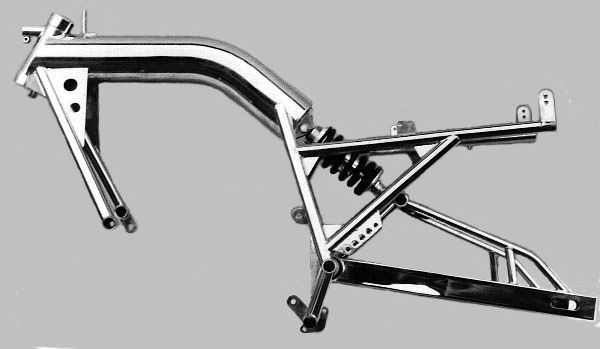1978 Behn Monoshock Frame

Engine as a stressed member. With the engine
installed the frame became triangulated. We had special bolts
made to secure the engine which were almost a press fit into the
Kawasaki engine cases. The four inch diameter backbone was bent
to allow Kawasaki Z1-cam cover removal. The large diameter gives
great torsional strength but the tube only had a wall thickness
of .0625" (1.5mm). Without the engine to complete the
triangulation the frame would flex. We shipped the frames with a
"faux engine strut" to keep the frame stiff until the final
engine installation. A Colin Chapman, Lotus-esque, approach to
chassis design. Light to win races which it did.
Amortisseurs DeCarbon monoshock with custom
valving. Timken bearings in neck and swingarm. Mild steel DOM
tubing. Might as well have been from the Twilight Zone when it
showed up in 1977. Competitors liked to protest it when it was
winning. Our answer at the time was anyone could order one.

Contrast our frame to
the, at the time, state-of-the-art "Featherbed" frame design
that everyone used...even the factory racers from Japan. Both
designs won races whereas center hub designs from various
designers like Andre
de Cortanze (ELF), James Parker, Bimota, Mead &
Tompkinson (Nessie) and others never had racing success.
No one really did
anything innovative for many years until Pierre Doncques (Godier
Genoud) and John Britten came along. Their monoshock designs
also won races. In the 1970's the Behn Monoshock won multiple
24h races, something that was still possible in that time frame.
Individuals could still outdo the factories...akin to F1
designers like John Barnard and Gordon Murray before 500
engineers got involved.
You do it when there is
a faint light at the end of the tunnel...then "pied au plancher"
(pedal to the metal).
Those days are long
gone.